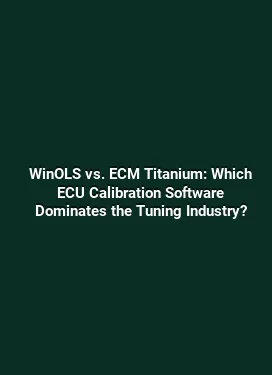The Role of CAN Bus in Modern Tuning: Data Logging and Real-Time Diagnostics
In the realm of engine management and performance tuning, the Controller Area Network (CAN) bus stands as a foundational technology that enables seamless communication between ECUs, sensors, actuators, and logging devices. As modern engines grow more complex with turbochargers, electrified powertrains, and advanced safety systems, the need for reliable, high-bandwidth data exchange becomes critical. This article delves into how CAN bus supports data logging, real-time diagnostics, and practical tuning workflows, offering concrete setups, myths debunked, and actionable strategies for engineers and enthusiasts alike.
Understanding CAN Bus Fundamentals in Automotive Tuning

CAN is a multi-master serial communication protocol designed for robust operation in automotive environments. Its fault-tolerant arbitration, non-destructive bitwise arbitration, and selective acknowledgment make it well-suited to high-noise conditions under the hood. In tuning contexts, CAN serves as the data backbone that transmits sensor readings, fault codes, control commands, and diagnostic information across multiple ECUs and auxiliary devices. A solid grasp of CAN concepts helps tuners make sense of data streams, identify bottlenecks, and design effective logging strategies.
Key concepts include the structure of CAN frames, message identifiers, and the way priority and timing influence data availability. Modern vehicles often employ high-capacity variants or extensions, and some networks use dual or multiplexed CAN buses to segregate critical control data from diagnostic traffic. Understanding how messages are prioritized prevents late-arriving data from skewing real-time analysis and ensures Logging Windows align with ECU update rates. By aligning the data request cadence with the engine’s dynamic events—such as boosted load transitions, throttle closures, or transient fuel changes—tuning workflows can capture meaningful deltas rather than noisy baselines.
CAN Bus Architecture

Most tuning-focused CAN implementations follow a layered approach: primary high-priority control messages travel on the backbone, while less critical telemetry and diagnostics ride on supplementary channels or sub-buses. Architecture choices impact how easily data can be collected without interfering with control loops. A typical setup partitions essential engine actuation data (injection timing, boost pressure, ignition advance) from sensor health metrics (temperatures, pressures, voltages) and from passenger comfort or safety systems. This separation helps maintain deterministic control while enabling rich observability for diagnostics and tuning experiments.
Message IDs and Priorities
CAN uses message identifiers to establish priority. In practical terms, the most critical engine functions are assigned higher priority IDs, ensuring their frames are transmitted with minimal latency. Tuning teams should map the IDs relevant to their platform, note any proprietary or vendor-specific frames, and document the expected data rates. This awareness allows for the design of logging schemes that capture high-value frames at appropriate sampling rates, while avoiding overflow or unnecessary data churn during extended sessions.
Setting Up CAN Bus Data Logging for Engine Management
Data logging turns the dynamic, real-time operations of an engine into a structured dataset that can be replayed, visualized, and analyzed. A robust CAN logging setup records relevant frames with synchronized timestamps, enabling traceability from sensor readings to control decisions. The goal is to create a practical data footprint that reveals the impact of tuning changes on air-fuel ratio, ignition timing, boost targets, and cooling system performance, among other critical parameters.
Effective logging starts with a clearly defined data schema. Identify which frames are essential for the current development phase, and define a target sampling rate that balances detail with storage constraints. Real-world engines may generate thousands of frames per second on busy CAN networks, so selective logging and efficient parsing are essential. Implement filtering rules to exclude noisy, redundant, or non-actionable frames, and ensure your storage medium supports fast read/write operations for both logging and subsequent analysis.
Hardware Interfaces
Hardware choices influence reliability and accessibility. Common options include OBD-II dongles with enhanced capabilities, standalone CAN interfaces connected to a PC or embedded logging unit, and OEM-grade calibration tools that expose specific diagnostic channels. For a robust tuning workflow, choose interfaces with proven signal integrity, proper grounding, and the ability to capture both standard CAN (2.0A/B) frames and any vendor-specific extensions. When working with high-speed CAN (CAN 2.0, CAN FD where supported), verify cable quality, termination, and shielding to minimize reflections and data corruption during high-load events.
Software Stack
A practical logging stack combines a real-time capture tool, a data parser, and a visualization layer. The capture tool should support timestamping with microsecond precision and the ability to filter or selectively record frames. A parser translates raw frames into interpretable signals, mapping IDs to engineering units such as °C, kPa, or mmHg. Visualization dashboards—whether local or cloud-based—should offer flexible time windows, cross-parameter correlation, and event tagging for quick triage during a tuning session.
Real-Time Diagnostics: What You Can Monitor
Real-time diagnostics transform tuning from a trial-and-error exercise into a data-driven discipline. By monitoring engine health, sensor integrity, and control logic in real time, tuners can identify anomalies, validate changes, and optimize responses under dynamic operating conditions. The interplay between data logging and real-time diagnostics is synergistic: live insights guide subsequent logging configurations, while logged data verifies the reliability of real-time observations.
Critical metrics span thermal conditions, air mass flow, fuel delivery, ignition and boost control, and electrical system health. Real-time dashboards should provide intuitive visual cues for rapid assessment, such as color-coded alerts when thresholds are exceeded, trend lines to observe drift, and synchronized plots to correlate actuator commands with observed outcomes. This approach supports both baseline validation and iterative tuning cycles, enabling faster convergence toward target performance and efficiency goals.
Live Telemetry Dashboards
Dashboard design matters: coherence, legibility, and responsiveness are essential. A well-structured dashboard presents core engine parameters alongside diagnostic indicators, with the ability to drill down into deeper data layers for post-session analysis. Features like time-sliced playback, waveform overlays, and auto-scaling help identify subtle interactions—such as how a rise in boost pressure influences ignition timing under high ambient temperatures. Consider designing separate panels for critical systems (fuel, ignition, boost) and secondary systems (battery health, sensor self-checks) to avoid cognitive overload during intense diagnostic sessions.
Anomaly Detection and Alarms
Real-time anomaly detection uses baseline models and threshold rules to flag departures from normal behavior. Examples include abnormal sensor readings, implausible ECU responses, or rapid sequence changes that precede misfires or knock events. Thoughtful alarm design balances sensitivity and usability: too many alerts can desensitize the operator, while too few may miss critical issues. Implement a tiered alert system with gradations (warning, critical) and ensure that alarm conditions are tied to actionable remediation steps, such as adjusting fuel trims, checking sensor wiring, or verifying actuator health.
Practical Examples: Case Studies and Tuning Scenarios
Real-world scenarios illustrate how CAN data logging and real-time diagnostics drive tangible improvements. From turbocharged gasoline engines to modern hybrids, the ability to capture relevant signals and correlate them with performance outcomes accelerates development and reduces risk. Case-based guidance helps practitioners translate theory into practice, highlighting common pitfalls and best practices across different powertrain configurations.
Case Study: Turbocharged Gasoline Engine Logging
A turbocharged setup benefits from detailed logging of boost target vs. actual, wastegate duty cycle, transient fueling, and intake air temperature. By correlating boost pressure spikes with ignition timing adjustments, a tuner can optimize transient response without compromising knock margins. Real-time diagnostics help catch sensor drift early, ensuring calibration remains within safe operating envelopes. The result is improved spool, smoother throttle response, and consistent engine life under high-load cycles.
Case Study: Hybrid Drivetrain Diagnostics
Hybrid systems introduce electric motor torque requests, battery state-of-charge signals, and vehicle-wide CAN traffic. A comprehensive logging scheme captures motor current, battery pack temperature, and state transitions between engine and electric propulsion. Real-time diagnostics alert operators to energy management anomalies, while trend analysis over multiple cycles reveals efficiency opportunities and potential reliability risks in wiring or sensor health. This approach supports seamless integration of mechanical and electrical control strategies for better overall performance.
Future Trends and Practical Considerations
As powertrain architectures evolve, CAN-based data logging and diagnostics continue to adapt. Trends include higher-resolution logging through CAN FD, richer diagnostic data via standardized and extended frames, and smarter onboard analytics that pre-process data before transmission. Practitioners should stay aware of evolving interfaces, such as multiprotocol gateways and over-the-air calibration enhancements, which extend the reach of in-vehicle data to external development environments without compromising safety or reliability.
Practical considerations encompass data governance, safety, and reliability. Ensuring data integrity through proper termination, shielding, and fault-tolerant design reduces the risk of corrupted signals. Maintaining calibration consistency across firmware updates and ECU revisions prevents misinterpretations of CAN data. Finally, documenting data flows, logging configurations, and diagnostic rules creates a repeatable, auditable workflow that supports scalable tuning projects across multiple platforms.






